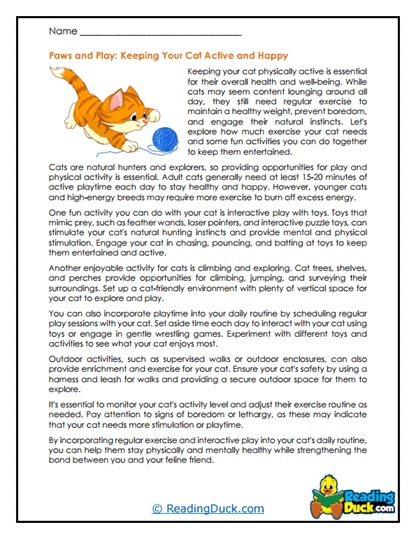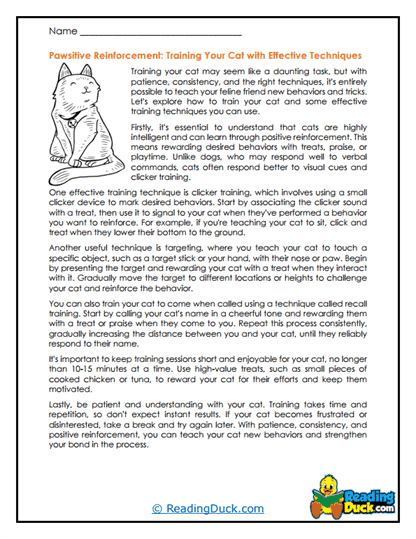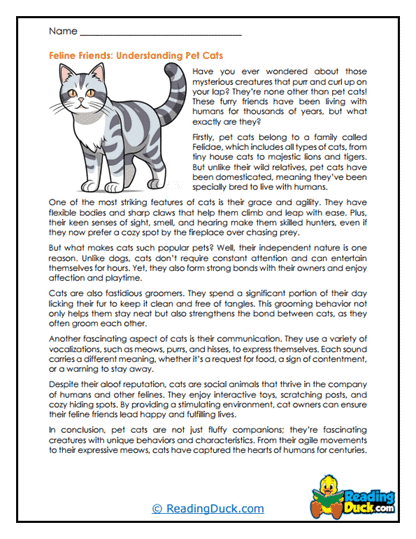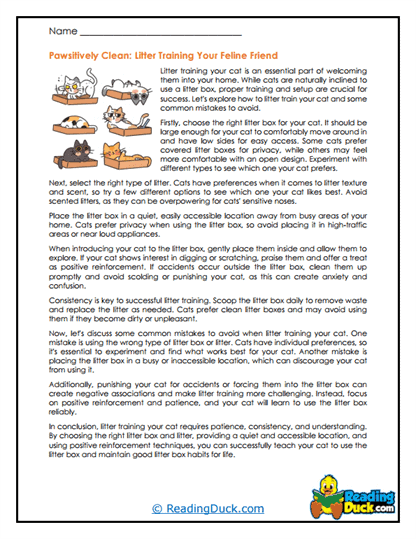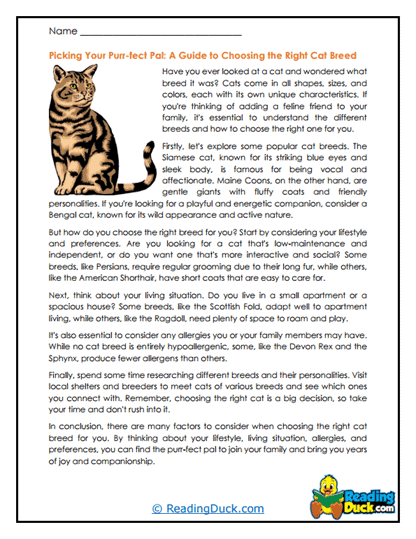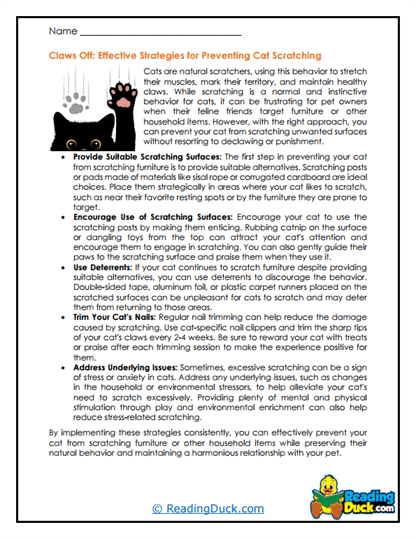Pet Cats Worksheets
About Our Pet Cats Worksheets
Our collection of Pet Cats worksheets provides an engaging and educational exploration into the world of one of the most beloved household pets, making it an excellent resource within the broader categories of Science: Biology and Animals. Cats have been companions to humans for thousands of years, and they continue to captivate us with their unique behaviors, independence, and charm. These worksheets are designed to help students explore the biology, behavior, and care of pet cats, while also enhancing their reading comprehension and critical thinking skills.
This collection is a subtopic within Biology and Animals and contains several worksheet sets. Each worksheet set includes:
- Multiple Choice Questions: These questions assess students' comprehension of the reading passage, ensuring they grasp the key concepts and details presented.
- Short Answer Questions: This section prompts students to write their responses, encouraging them to articulate their understanding in their own words. This exercise helps reinforce their knowledge and improves their ability to communicate scientific information effectively.
- Open-Ended Questions: These questions invite students to share their personal thoughts, opinions, and reflections on the material, fostering critical thinking and allowing them to connect more deeply with the content.
Each worksheet is accompanied by a detailed answer key, making it easy for educators and parents to review students' work. The worksheets are provided in PDF format, ensuring they can be easily viewed electronically, downloaded, and printed.
Understanding Our Feline Friends: An Exploration of Pet Cats
When introducing students to the topic of pet cats, it’s essential to highlight the unique qualities that make these animals so special. Cats are independent, intelligent, and curious creatures with a rich history of domestication. Understanding cats involves exploring their biology, behavior, and the various roles they play in human society. Cats come in a wide variety of breeds, each with unique traits, and they have been beloved companions across different cultures and times.
To help students gain a comprehensive understanding of pet cats, we can explore the topic through the following key areas:
The Evolution and Domestication of Cats: Cats have a fascinating history that dates back thousands of years:
- Origins: Domestic cats are descendants of the African wildcat, a species that still exists today. The domestication of cats likely began around 9,000 years ago in the Near East, where humans first started farming and storing surplus grain. Cats were attracted to the grain stores because of the rodents that came with them, and over time, a mutually beneficial relationship developed between humans and cats.
- Domestication Process: Unlike dogs, which were actively bred by humans for specific traits, cats domesticated themselves to some extent. They maintained much of their wild behavior and independence, but over time, they adapted to living alongside humans, forming the basis for the diverse domestic cat breeds we see today.
- Roles in Human Society: Cats have played various roles throughout history, from revered protectors of food stores to companions that provide comfort and affection. In ancient Egypt, cats were worshiped and even mummified, while in other cultures, they were valued for their ability to control pests.
Diversity of Cat Breeds: The world of cats is incredibly diverse, with many recognized breeds, each with its own characteristics and behaviors:
- Breed Characteristics: Different breeds of cats have been developed for various physical traits, such as coat type, color, and body shape. For example, the Siamese cat is known for its slender body and striking blue eyes, while the Persian cat is recognized for its long, luxurious fur and flat face.
- Temperament and Behavior: Each breed also has distinct temperament traits. For instance, the Maine Coon is known for its friendly and sociable nature, making it a great family pet, while the Abyssinian is known for its high energy and playful behavior.
- Mixed Breed Cats: While purebred cats have specific characteristics, many cats are mixed breeds, commonly known as domestic shorthairs or domestic longhairs. These cats can vary widely in appearance and personality, making each one unique.
Understanding Cat Behavior: Cats have a range of behaviors that can sometimes be puzzling to their human companions:
- Body Language: Cats communicate a lot through their body language, including their posture, tail movements, and ear positions. For example, a cat with its tail held high is usually confident and happy, while a cat with flattened ears may be feeling threatened or frightened.
- Vocalizations: Cats use various sounds to communicate, including meowing, purring, hissing, and growling. Each sound can convey different meanings, depending on the context and the individual cat’s personality. For example, purring is often associated with contentment, but cats may also purr when they are anxious or in pain.
- Play and Hunting: Play is an important part of a cat’s life, particularly for kittens. It helps them develop their hunting skills, which are still strong even in domesticated cats. Providing appropriate toys and playtime is crucial for a cat’s mental and physical health.
The Health and Care of Cats: Proper care is essential for keeping cats healthy and happy:
- Nutrition: Cats are obligate carnivores, meaning they require a diet that is primarily composed of meat. It’s important to feed them a balanced diet that meets their nutritional needs, including essential nutrients like taurine, which is crucial for their heart and eye health.
- Exercise and Mental Stimulation: While cats are known for their love of sleep, they also need regular exercise to stay healthy. Providing opportunities for play, climbing, and exploration can help prevent obesity and keep their minds sharp.
- Grooming and Hygiene: Some cats require more grooming than others, particularly long-haired breeds like Persians. Regular brushing helps prevent matting and reduces shedding. It’s also important to maintain their dental health by providing dental treats or regular brushing.
- Veterinary Care: Regular check-ups with a veterinarian are essential for monitoring a cat’s health. Vaccinations, parasite prevention, and dental care are all critical components of veterinary care, helping to protect cats from diseases and other health issues.
The Human-Cat Bond: The relationship between humans and cats is unique and multifaceted:
- Companionship: Cats provide companionship and comfort to their owners, often forming strong bonds with their human families. Their independent nature means they can be left alone for longer periods than dogs, but they still enjoy interaction and affection.
- Therapeutic Benefits: Many studies have shown that interacting with cats can have therapeutic benefits, including reducing stress and anxiety. Cats are often used in therapy settings, where their calming presence can help people feel more at ease.
- Responsibility and Care: Owning a cat teaches responsibility, compassion, and empathy. By caring for a cat, students can learn about the importance of meeting the needs of another living being, developing life skills that will benefit them in all areas of their lives.
By exploring these aspects of pet cats, students can develop a comprehensive understanding of these fascinating animals. These worksheets will guide them through the biology, behavior, and care of cats, sparking curiosity and encouraging them to think critically about the role cats play in human lives.
Creative Uses For These Worksheets
Integrating our Pet Cats worksheets into a school or homeschool curriculum offers numerous opportunities to enhance students' understanding of Biology and the animal kingdom. Here are some creative ideas on how educators and parents can effectively use these worksheets in various educational settings:
- Unit-Based Learning: These worksheets can be used as part of a broader unit on Biology, Life Sciences, or Animal Studies. After introducing students to basic biological concepts such as genetics, evolution, and animal behavior, the topic of pet cats can be explored in greater depth using these worksheets. The worksheets can serve as the foundation for discussions, experiments, and further research on cats and their unique relationship with humans.
- Classroom Discussions and Group Activities: Encourage students to work in pairs or small groups to discuss the reading passages and answer the questions together. This collaborative approach helps students articulate their thoughts, listen to different perspectives, and deepen their understanding of the material. The open-ended questions, in particular, are excellent for sparking class discussions, where students can share their ideas and engage in debates about the roles cats play in society and how to care for them responsibly.
- Research Projects and Presentations: After completing the worksheets, students can be assigned to research and present on specific cat breeds, the history of cat domestication, or the roles of cats in different cultures. They can also explore topics like the impact of pet ownership on human health, the ethics of breeding practices, or the importance of rescue and adoption programs. These projects can culminate in presentations, reports, or creative displays, allowing students to showcase their knowledge and enthusiasm for the subject.
- Multimedia Integration: Pair the worksheets with documentaries, videos, or interactive apps about cats. For example, students can watch a documentary on the history of cat domestication and then complete the worksheets to reinforce what they’ve learned. Using multimedia can cater to different learning styles and help make the topic more engaging and accessible.
- Cross-Curricular Connections: Use the Pet Cats worksheets to make connections across different subjects. In an English class, students could write essays or creative stories inspired by what they've learned about cats. In art class, they could create drawings or models of cats and their habitats. This interdisciplinary approach helps students see how different areas of study intersect and reinforces their learning in a more holistic way.
By incorporating these Pet Cats worksheets into the curriculum, teachers and parents can provide students with a comprehensive and engaging learning experience. These worksheets are designed to help students explore the biology, behavior, and care of cats, develop critical thinking skills, and foster a lifelong appreciation for these independent and fascinating animals. Whether used in the classroom or at home, these resources will inspire students to understand and care for cats in a more informed and compassionate way.
